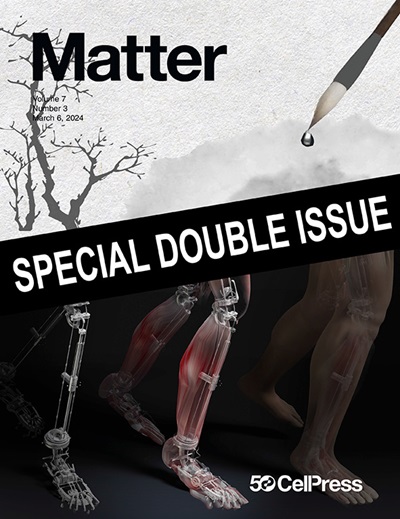用于智能软电子器件的粘弹性聚合物复合凝胶仿生导体
IF 17.3
1区 材料科学
Q1 MATERIALS SCIENCE, MULTIDISCIPLINARY
引用次数: 0
摘要
生物体内的神经系统在感知、反应和学习方面实现了高度优化,这对于...本文章由计算机程序翻译,如有差异,请以英文原文为准。

Biomimetic conductor from viscoelastic polymer composite gels for smart soft electronics
The neural system in living organisms has achieved highly optimized features in perception, response, and learning, which are extremely desirable for modern soft robots. Today’s soft robots generally utilize flexible conductors to fabricate their sensory systems. Such a system usually exhibits instantaneous response behaviors upon external stimuli without signal persistence or environmental adaptability to protect living organisms. This work provides a bio-conductor based on viscoelastic polymer gels and metal microfibers. The flexible bio-conductor can achieve critical sensory persistence and adaptation via efficient control over the electrical conductive network through relaxation of metal microfibers and polymer chains. The signal transmission in the bio-conductor can be conveniently mediated through the parameters of the composites, exhibiting unique responses to diverse environmental conditions. An aerial vehicle integrated with the bio-conductor, and a microcontroller unit (MCU) was successfully fabricated for a robot system to simulate the signal transmission, processing, and response in biological nervous systems.
求助全文
通过发布文献求助,成功后即可免费获取论文全文。
去求助
来源期刊

Matter
MATERIALS SCIENCE, MULTIDISCIPLINARY-
CiteScore
26.30
自引率
2.60%
发文量
367
期刊介绍:
Matter, a monthly journal affiliated with Cell, spans the broad field of materials science from nano to macro levels,covering fundamentals to applications. Embracing groundbreaking technologies,it includes full-length research articles,reviews, perspectives,previews, opinions, personnel stories, and general editorial content.
Matter aims to be the primary resource for researchers in academia and industry, inspiring the next generation of materials scientists.
 求助内容:
求助内容: 应助结果提醒方式:
应助结果提醒方式:


